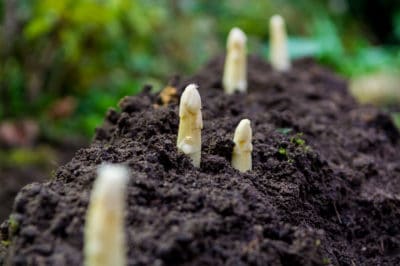When to Start a Bed of Asparagus
The best time of year to start a new bed of asparagus depends on where you live.
- In the central and eastern United States where snow and cold winters are common, asparagus is most often planted in April and early May.
- In coastal northwestern states and areas with similar climates, this crop can be planted in January through March.
- In the inland areas of Southern California and in Southern states with hot summers and mild winters, asparagus is planted from October through March.
- In the central agricultural regions of Sacramento and San Joaquin valleys in California, asparagus beds are started between January and March.
Choosing a Site for an Asparagus Patch
Because asparagus plants are large, long-lived, and produce at the rate of about three spears per plant per season, these plants require a fairly large, permanent planting bed.
Asparagus can be grown from seed or from root stock called crowns, taking three for crowns and four years for seeds until the plants reach maturity and full production.
Planting 10 crowns per person produces a reasonable harvest for most home gardeners, but plant more than this if you want to preserve part of what you grow or if you like eating large amounts of this spring vegetable.
Preparing a bed for asparagus can be a big job, so starting well before it is time to plant the crowns is a good idea. However, a well-prepared site pays off in a large harvest for many years, making it worth the investment of time and materials.
Preparing the Soil for Asparagus
Because a planting of asparagus is perennial and will last for as long as 20 years, deep preparation of the soil helps plants reach their potential in size and production of spring shoots for eating.
Asparagus needs a well-drained site, meaning water should drain out of a previously wetted hole of 1 cubic foot (28 cubic liters) square volume at the rate of at least 1 inch (2.5cm) per hour. If drainage at your site is slow, consider building a raised bed and filling it with sandy-loam soil mixed with generous amounts of compost to create better drainage for the plants.
If you are planting in the ground, dig down at least one foot and add large amounts of compost, decomposed animal manure, leaf mold or a mixture of these materials to add organic matter, plant nutrients, and improve drainage. Organic matter also helps retain water if drainage is too fast.
At the bottom of the planting trench, mix in a 5-10-5 fertilizer into the soil and then cover it with about 2 inches (5cm) of soil before placing the crowns in the trench. Cover the crowns with at least 2 inches (5cm) of soil after placing them in the trench.
Planting Asparagus
Plant asparagus crowns in a trench dug approximately 16 inches (40cm) wide and 6 inches (15cm) deep, and then space individual crowns 9 inches (23cm) to 18 inches (45.7cm) apart in the trench. Grow plants in a block of two or more rows spaced 3 feet (.9 meters) to 4 feet (1.2 meters) apart.
If you plant 2 rows 4 feet (1.2 meters) apart, and you plant a total of 20 crowns at 1 foot (30.5cm) spacing in each row, you will need an area of 4 feet (1.2 meters) by 10 feet (3 meters) in size for your asparagus patch.
If you are planting more or less plants, adjust the size of the bed accordingly, and then prepare the soil in the entire area by digging in compost, leaf mold, decomposed manure, or other organic matter to improve drainage, space for roots to grow, and to increase soil fertility.
Caring for Asparagus after Planting
Asparagus plants produce edible shoots in the spring, and these shoots then grow into tall ferns with numerous small leaves and attractive, small, red berries on female plants in the fall. However, female plants are less productive than males.
Harvest shoots when they are between 6 inches (15cm) and 10 inches (25.4cm) long. However, shoots must be left to grow for the first three years, so they produce grown fern stems and leaves for providing energy to the growing roots.
Irrigate the bed regularly, especially in the spring and after planting. Later in the season, when the ferns have died back, you can reduce or stop irrigation for the winter.
